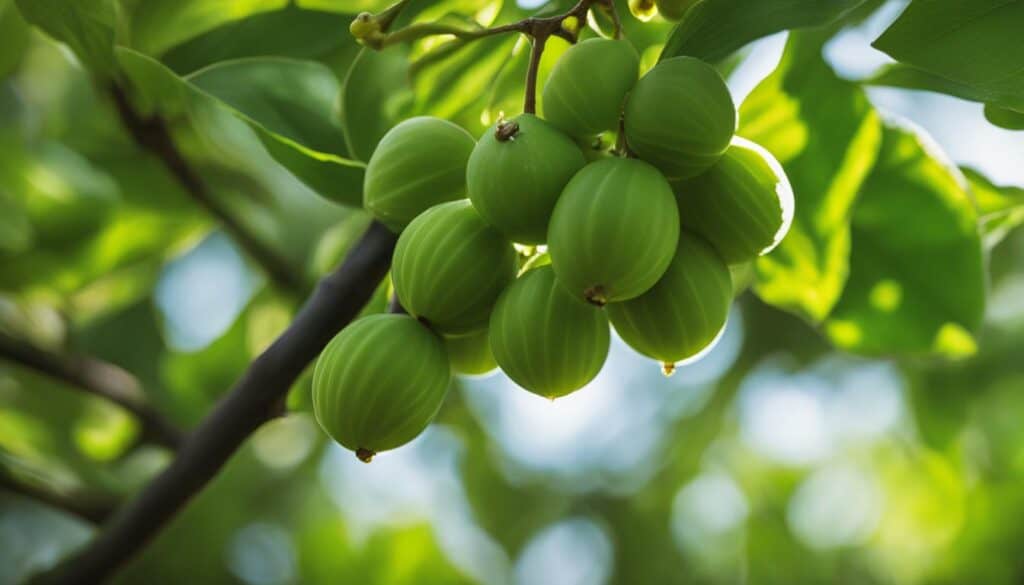The Amla fruit, also known as Indian Gooseberry, is a plant of great significance in Indian culture and has been extensively studied for its health benefits. It is revered in mythology and is celebrated during a holiday called Amla Navami. The fruit has been used traditionally for various purposes, including respiratory conditions, cardiovascular support, neoplasms prevention, metabolic and endocrine functions, sexual health, and digestion support. It is rich in antioxidants, particularly hydrolysable tannins, and vitamin C, which contribute to its health-promoting properties. Research also suggests that Amla can support cardiovascular health, improve digestion, and aid in the absorption of nutrients. With its diverse range of benefits, the Amla tree continues to be a subject of scientific inquiry and is highly valued in holistic medicine.
Key Takeaways:
- The Amla tree is highly regarded in Indian culture and has multiple health benefits.
- It has been traditionally used for respiratory conditions, cardiovascular support, and digestion.
- Amla is rich in antioxidants and vitamin C, which contribute to its health-promoting properties.
- Research suggests its potential benefits for cardiovascular health and digestion.
- The Amla tree is a valued resource in holistic medicine.
Amla Tree in Ayurveda
In the ancient practice of Ayurveda, the Amla tree holds a revered position as a powerful medicinal herb. Known as “sarvadosha hara,” or the remover of all diseases, the Amla tree is believed to have manifested from the tears of Brahma during meditation. Its rich history and significance in Ayurveda showcase its profound role in traditional medicine.
Amla, also known as Indian Gooseberry, is highly valued in Ayurvedic medicine for its numerous health benefits. One of its key attributes is its antioxidant properties, which help protect the body against free radicals. Additionally, the Amla tree is renowned for its high vitamin C content, making it a powerful ally in supporting the immune system, liver function, brain health, heart health, and fertility.
Ayurvedic practitioners also utilize Amla for its positive effects on digestion. It is believed to improve overall digestive health, promote healthy bowel movements, and support the body’s natural inflammatory response. Furthermore, Amla is known to promote healthy blood sugar levels, gum health, eye health, and blood circulation.
The Role of Amla in Ayurvedic Medicine
With its deep roots in Ayurvedic medicine, the Amla tree continues to be recognized for its holistic healing properties. Its antioxidant power, vitamin C content, and ability to support various bodily functions make it a valuable resource in promoting overall health and well-being.
Amla Tree Benefits in Ayurveda:
- Removal of all diseases (sarvadosha hara)
- Supports the immune system
- Boosts liver function
- Enhances brain health
- Improves heart health
- Aids fertility
- Promotes digestive health
- Supports healthy blood sugar levels
- Enhances gum and eye health
- Improves blood circulation
As Ayurveda continues to thrive and evolve, the Amla tree remains a cherished ally in the pursuit of optimal health and well-being.
Amla Tree Nutrition and Antioxidant Power
The Amla fruit, also known as Indian Gooseberry, is not only revered for its cultural significance but also for its incredible nutritional value. This fruit is a powerhouse of essential nutrients, making it a valuable addition to a healthy diet. Amla is particularly known for its exceptionally high vitamin C content, containing approximately 600-800% of the Daily Value (DV) in just one berry. This makes it an excellent natural source of this vital antioxidant vitamin.
In addition to vitamin C, the Amla fruit is packed with other essential vitamins and minerals that contribute to its overall nutritional profile. It contains vitamins B5 and B6, which are important for energy production and the maintenance of a healthy nervous system. Amla also provides minerals such as copper, manganese, and potassium, which play crucial roles in various bodily functions.
One of the key aspects of the Amla fruit’s nutritional profile is its antioxidant power. Amla is rich in antioxidants such as hydrolysable tannins, alkaloids, and phenolic compounds. These antioxidants help fight against free radicals, unstable molecules that can cause oxidative stress and damage cells. By protecting cells from oxidative damage, Amla’s antioxidants support overall health and well-being.
Here is a table summarizing the key nutrition facts and antioxidant properties of Amla:
| Nutrient | Amount per 100g |
|---|---|
| Calories | 44-70 kcal |
| Protein | 0.8-1g |
| Fat | 0.5g |
| Carbohydrates | 10g |
| Fiber | 4.3g |
| Vitamin C | 27.7-800mg (44-1300% DV) |
| Vitamin A | 290 IU (6% DV) |
| Vitamin E | 0.16mg |
| Calcium | 25mg (3% DV) |
| Iron | 0.9mg (6% DV) |
| Magnesium | 10mg (2% DV) |
| Potassium | 198mg (6% DV) |
| Copper | 0.1mg (4% DV) |
| Manganese | 0.1mg |
| Polyphenols | Gallic Acid: 3012.5mg |
| Antioxidant Power | Very high, often ranked #1 among whole foods |
Key points:
- Very low in calories and fat, high in fiber and micronutrients like vitamins C, A, E and minerals.
- Extremely high in antioxidant polyphenols like gallic acid. Considered one of the best antioxidant whole foods.
- Multiple health benefits seen in research related to immunity, digestion, diabetes, heart health, anti-aging and more.
- Both the fruit and dried amla powder provide concentrated nutrition.
Amla Tree for Digestion and Gut Health
The Amla tree has long been recognized for its positive effects on digestion and gut health. Consuming Amla can help alleviate digestive issues such as heartburn and upset stomach symptoms. Its high fiber content supports regular bowel movements and contributes to overall gut health. Amla extract has also shown promising results in protecting the stomach lining from injury and inflammation.
Amla’s benefits for digestion go beyond symptom relief. It provides essential dietary fiber, which promotes a healthy gut microbiome and aids in the body’s natural inflammatory response. These properties make Amla a valuable addition to a balanced diet and a natural remedy for digestive discomfort.
The Amla Tree and Gut Microbiome
The gut microbiome, made up of trillions of microorganisms in the digestive tract, plays a crucial role in digestion, nutrient absorption, and overall health. Amla’s fiber content serves as a prebiotic, providing nourishment for beneficial gut bacteria. By supporting a diverse and healthy gut microbiome, Amla contributes to optimal digestion and improved gut health.

Amla’s impact on gut health is not solely limited to digestion. Research suggests that a healthy gut microbiome is linked to various aspects of overall well-being, including immune function, mental health, and metabolism. By incorporating Amla into your diet, you can enhance your digestive health and contribute to a balanced gut microbiome.
Amla Tree for Cardiovascular Health
The Amla tree, with its rich nutritional profile and antioxidant power, offers numerous benefits for cardiovascular health. Research has shown that the consumption of Amla fruit and extracts can have a positive impact on heart health by supporting healthy blood vessels, reducing LDL cholesterol levels, and preventing inflammation.
One clinical trial conducted on obese patients found that supplementation with Amla extract resulted in a significant reduction in LDL cholesterol, platelet aggregation, and inflammation levels. These findings highlight the potential of Amla as a natural and effective way to improve cardiovascular health.
To further understand the impact of Amla on cardiovascular health, let’s take a closer look at a comparative table showcasing its key benefits:
| Benefit | Amla Tree | Other Options |
|---|---|---|
| Supports healthy blood vessels | ✓ | ✕ |
| Reduces LDL cholesterol | ✓ | ✕ |
| Prevents inflammation | ✓ | ✕ |
| Improves liver function | ✓ | ✕ |
As seen in the table, the Amla tree stands out as a powerful natural option for cardiovascular health. Its comprehensive benefits, including supporting healthy blood vessels, reducing LDL cholesterol levels, and preventing inflammation, make it a valuable addition to a heart-healthy regimen.
Amla Tree for Hair and Skin
The Amla fruit, also known as Indian Gooseberry, has a long-standing reputation for its positive effects on hair and skin. It is believed to promote hair growth, strengthen hair follicles, and prevent premature graying. Amla oil, derived from the fruit, is commonly used in natural hair care remedies. Its nutrient-rich properties nourish the scalp and help maintain healthy hair.
When it comes to skincare, Amla is equally beneficial. Its high vitamin C content and antioxidant properties contribute to a healthy complexion. Amla helps nourish the skin and protect against free radicals, which can cause premature aging. Using Amla-based beauty products can provide the skin with essential nutrients and support its natural radiance.
Amla’s versatility and effectiveness in improving hair and skin health have made it a popular choice for those seeking natural remedies. Its holistic approach to beauty not only focuses on external beauty but also enhances overall well-being.

| Benefits of Amla for Hair | Benefits of Amla for Skin |
|---|---|
|
|
Amla Tree in Herbal Medicine
The Amla tree has a long history of use in herbal medicine, where it is valued for its therapeutic properties. Its antioxidant, anti-inflammatory, and immune-strengthening effects have made it a staple ingredient in traditional remedies.
One of the key benefits of the Amla tree in herbal medicine is its ability to support healthy inflammatory levels in the body. This makes it a valuable tool in managing conditions related to inflammation, such as arthritis and allergies.
Additionally, Amla is known for its role in supporting healthy blood sugar levels. It has been used for centuries to help regulate blood glucose levels, making it a natural remedy for individuals with diabetes or those at risk of developing the condition.
The Amla tree is also known for its positive effects on gum health, eye health, and blood circulation. It is often used to address issues such as gum inflammation, dry eyes, and poor blood circulation, thanks to its potent antioxidant properties and nutrient-rich composition.
With its long-standing history and proven efficacy, the Amla tree continues to be a valuable asset in the world of herbal medicine. Its versatility and wide range of health benefits make it a popular choice for those seeking natural remedies.

Amla Tree Cultivation and Natural Remedies
The cultivation of the Amla tree is primarily concentrated in various parts of India, where it thrives in tropical and subtropical climates. The tree is known for its adaptability and resilience, making it suitable for cultivation in diverse environments. Amla trees are usually propagated through seed germination or grafting techniques, with careful attention given to the selection of high-quality seeds or healthy rootstock. The trees require well-drained soil and ample sunlight to ensure optimal growth and fruit production.
Once the Amla tree is established, it requires regular watering and occasional fertilization to support its growth. Pruning is also important to maintain the tree’s shape and promote better fruit yield. It takes several years for the Amla tree to bear fruit, with the first harvest typically occurring three to four years after planting. The fruit is harvested by hand, ensuring careful handling to avoid damage.
The Amla tree’s natural remedies come in various forms, providing a range of options for those seeking its health benefits. A popular method of consumption is the fresh fruit, which can be eaten on its own or used in various culinary preparations. The dried fruit is commonly used to make Amla powder, which is incorporated into herbal teas or mixed with other ingredients for natural remedies. Amla extracts and oils are also available, offering convenient ways to incorporate its health-promoting properties into daily routines. Whether consumed fresh, dried, or in extract form, the Amla tree’s natural remedies provide a holistic approach to wellness.
| Table: Forms of Amla Tree Natural Remedies | |
|---|---|
| Form | Description |
| Fresh Fruit | The Amla fruit is consumed as is or used in culinary preparations. |
| Dried Fruit | Amla fruit is dried and ground into a powder for various applications. |
| Extracts | Concentrated Amla extracts are available in liquid or capsule form. |
| Oils | Amla oil is used for hair and scalp care, offering nourishing benefits. |
The Amla tree’s natural remedies provide a holistic approach to wellness.
With its versatility and availability in different forms, the Amla tree continues to be explored for its potential as a natural remedy. Its rich nutritional profile and health-promoting properties make it a valuable resource in supporting overall health and well-being. From its cultivation to the various natural remedies derived from its fruit, the Amla tree offers a world of possibilities for those seeking natural and holistic solutions for their health needs.

Conclusion
The Amla tree, with its revered status in Indian culture and extensive scientific research, offers a wealth of health benefits. From its antioxidant power to its role in digestion, cardiovascular health, hair and skin care, and herbal medicine, the Amla tree has proven to be a versatile and valuable resource.
Its rich history in Ayurveda and its popularity in natural food circles demonstrate its significance in holistic medicine. As research into the Amla tree continues to grow, it is evident that this tree truly offers a world of wonders for overall health and well-being.
FAQ
What is the Amla fruit?
The Amla fruit, also known as Indian Gooseberry, is a plant of great significance in Indian culture and has been extensively studied for its health benefits.
What are the traditional uses of Amla?
Amla has been traditionally used for respiratory conditions, cardiovascular support, neoplasms prevention, metabolic and endocrine functions, sexual health, and digestion support.
What nutrients does Amla contain?
Amla is rich in antioxidants, particularly hydrolysable tannins, and vitamin C. It also provides vitamin B5 and B6, copper, manganese, potassium, and fiber.
How does Amla benefit digestion and gut health?
Amla has been found to reduce heartburn, regulate bowel movements, protect against stomach lesions, and promote overall gut health.
What role does Amla play in cardiovascular health?
Amla supports heart health by maintaining healthy blood vessels, reducing LDL cholesterol, platelet aggregation, and inflammation levels, and improving liver function and cholesterol regulation.
How does Amla benefit hair and skin?
Amla promotes hair growth, strengthens hair follicles, prevents premature graying, nourishes the skin, protects against free radicals, and promotes a healthy complexion.
How is Amla used in herbal medicine?
Amla is known for its antioxidant, anti-inflammatory, and immune-strengthening effects. It is used to manage various inflammatory conditions, support healthy blood sugar levels, gum health, eye health, and blood circulation.
How is the Amla tree cultivated and used in natural remedies?
The Amla tree is cultivated in various parts of India and is consumed as a fresh fruit, included in meals, or used in powdered form, extracts, oils, and teas for its health benefits.
What are the overall benefits of the Amla tree?
The Amla tree offers a wide range of benefits for overall health and well-being, including antioxidant power, digestion support, cardiovascular health, hair and skin care, and herbal medicine.





Leave a Reply